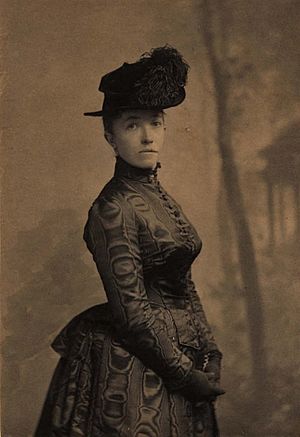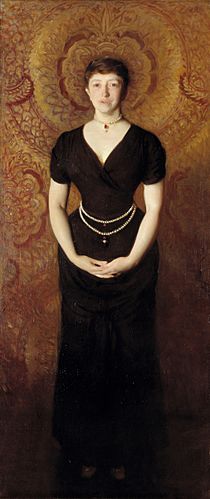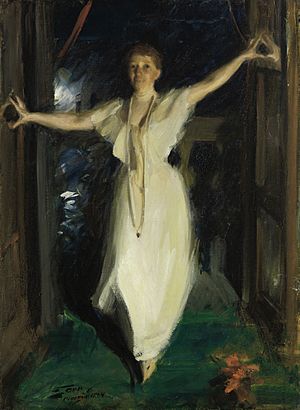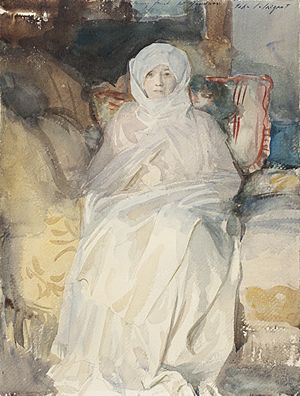Isabella Stewart Gardner facts for kids
Quick facts for kids
Isabella Stewart Gardner
|
|
|---|---|

Isabella Stewart Gardner in 1888
|
|
| Born |
Isabella Stewart
April 14, 1840 |
| Died | July 14, 1924 (aged 84) |
| Occupation | Philanthropist |
| Known for | Founder of Isabella Stewart Gardner Museum |
| Spouse(s) | John Lowell Gardner II |
Isabella Stewart Gardner (April 14, 1840 – July 17, 1924) was a very important American art collector. She was also a philanthropist, meaning she gave a lot of money to good causes. Isabella loved art and helped many artists.
She is famous for starting the Isabella Stewart Gardner Museum in Boston. Isabella was very curious and loved to travel. She was friends with many famous artists and writers of her time. These included John Singer Sargent, Henry James, and Anders Zorn.
Isabella was known for her stylish tastes and unique behavior. People in Boston often talked about her. They called her "Belle" or "Mrs. Jack." Once, in 1912, she went to a formal concert. She wore a white headband that said "Oh, you Red Sox!" This caused quite a stir and is still a famous story about her.
Contents
Isabella's Early Life

Isabella Stewart was born in New York City on April 14, 1840. Her father, David Stewart, was a rich linen merchant. She grew up in Manhattan. From age five to fifteen, she went to a girls' school. There, she studied art, music, dance, French, and Italian.
When she was 16, Isabella and her family moved to Paris. She went to a school for American girls. Some of her classmates were from the wealthy Gardner family of Boston. In 1857, she visited Italy. In Milan, she saw Gian Giacomo Poldi Pezzoli's art collection. It was arranged in rooms that looked like different historical times. Isabella said then that if she ever got money, she would create a similar house for people to visit.
She returned to New York in 1858. Soon after, her friend Julia Gardner invited her to Boston. There, Isabella met Julia's brother, John Lowell "Jack" Gardner. He was three years older than her. Jack was one of Boston's most wanted bachelors.
They married on April 10, 1860. Isabella's father gave them a house at 152 Beacon Street in Boston. They lived there for the rest of Jack's life.
Jack and Isabella had one son, born in 1863. Sadly, he died from pneumonia in 1865. A year later, Isabella had a miscarriage. Doctors told her she could not have more children. Her close friend and sister-in-law also died around this time. Isabella became very sad and stopped seeing people.
Doctors suggested she and Jack travel to Europe in 1867. Isabella was so sick that she had to be carried onto the ship. They traveled for almost a year, visiting Scandinavia and Russia. Most of their time was spent in Paris. The trip helped Isabella feel much better. It was a turning point in her life. During this trip, she started keeping scrapbooks of her travels. When she returned, she became known as a stylish and lively person in society.
In 1875, Jack's brother, Joseph P. Gardner, died. He left behind three young sons. Jack and Isabella took care of the boys. Augustus P. Gardner was 10 years old at the time. Isabella was a very caring and responsible guardian to them.
Isabella's Travels and Art Collecting

In 1874, Isabella and Jack Gardner visited the Middle East, Central Europe, and Paris. From the late 1880s, they traveled often. They went across America, Europe, and Asia. They wanted to learn about different cultures and art from all over the world. Jack and Isabella took more than a dozen trips abroad. They spent a total of ten years outside the country.
The first artworks in the Gardners' collection came from their trips to Europe. In 1891, Isabella inherited $1.75 million from her father. She then started to focus on collecting European fine art. One of her first big purchases was The Concert by Vermeer. She bought it at an auction in Paris in 1892. She also collected art from places like Egypt, Turkey, and the Far East.
The Gardners began collecting seriously in the late 1890s. They quickly built a world-class collection. It included paintings, sculptures, tapestries, photographs, silver, and old books. They even collected parts of buildings, like doors and stained glass.
In the early 1900s, Isabella traveled with her friend Edmund March Wheelwright. He was an architect from Boston. They collected items for the Harvard Lampoon Building. This building was designed to look like a Flemish castle. Isabella gave many art pieces to this "Lampoon Castle." The value of this collection is not fully known.
Isabella Stewart Gardner's favorite foreign place was Venice, Italy. The Gardners often stayed at the Palazzi Barbaro. This was a major art center for American and English people living in Venice. They visited Venice's art treasures with Ralph Curtis, an artist from Boston. In Venice, Isabella bought art and old items. She also went to the opera and dined with artists and writers.
Creating the Museum
By 1896, Isabella and Jack Gardner knew their house was too small. Even after making it bigger, it could not hold all their art. They had works by famous artists like Botticelli, Vermeer, and Rembrandt. After Jack's sudden death in 1898, Isabella decided to make their shared dream come true. She would build a museum for their treasures.
She bought land for the museum in the marshy Fenway area of Boston. She hired architect Willard T. Sears. Isabella wanted the museum to look like the Renaissance palaces of Venice. She was very involved in every part of the design. Sears even joked that he was just the engineer helping Isabella's ideas come to life.
The building completely surrounds a glass-covered garden courtyard. This was the first of its kind in America. Isabella planned for the second and third floors to be art galleries. There was a large music room that went across the first and second floors. Later, Isabella divided this room. She made space to show a large John Singer Sargent painting called El Jaleo on the first floor. Tapestries were displayed on the second floor.
Once the building was ready, Isabella spent a year carefully arranging her collection. She placed everything according to her own artistic style. The museum has a mix of paintings, sculptures, textiles, and furniture. They come from different times and cultures. This creates a rich and unique story for visitors.
The Isabella Stewart Gardner Museum opened privately on January 1, 1903. There was a big party with music from the Boston Symphony Orchestra. The menu included champagne and doughnuts. The museum opened to the public a few months later. It showed paintings, drawings, furniture, and other items. These ranged from ancient Egypt to works by Matisse. Today, the museum is still arranged with textiles, furniture, and paintings from floor to ceiling.
Later Years and Passing

In 1919, Isabella Stewart Gardner had her first stroke. She passed away five years later, on July 17, 1924. She was 84 years old. Isabella is buried in the Gardner family tomb at Mount Auburn Cemetery. This cemetery is in Watertown and Cambridge. She rests between her husband and her son.
Isabella's Lasting Impact
After Isabella's death, the fourth floor of the museum was used as the director's home for over sixty years. Isabella herself used the fourth floor as her home when she was alive. Later, it was changed into offices for the museum staff.
Isabella's will created a special fund of $1 million for the museum. She also set rules for how the museum should be run. One rule was that the main art collection should not be changed much. Showing her kind nature, her will also left large gifts to other charities. These included the Massachusetts Society for the Prevention of Cruelty to Children and the Animal Rescue League of Boston.
Isabella Stewart Gardner was a close supporter of many artists, writers, and musicians. She was a skilled traveler and a smart collector. She was a very important person in American society and culture. In Boston, people called her the "Queen of the Back Bay."
The place where her old home used to be is now a stop on the Boston Women's Heritage Trail.
Images for kids
See also
 In Spanish: Isabella Stewart Gardner para niños
In Spanish: Isabella Stewart Gardner para niños



